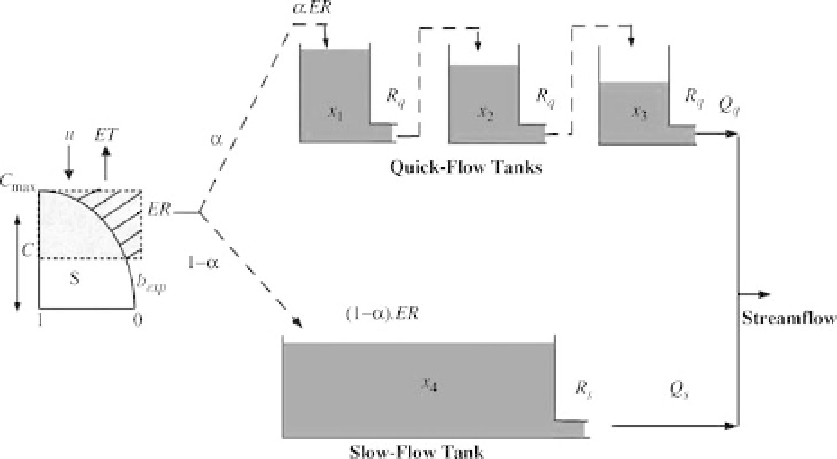Environmental Engineering Reference
In-Depth Information
taneous effect (i.e. a flow effect resulting from
rainfall falling within the same day). Clearly,
therefore, one-day-ahead flow forecasting, with-
out an accompanying one-day-ahead forecast of
the rainfall, presents quite a challenge. In addition,
the imposition of constraints on the model struc-
ture so that it has real eigenvalues and is similar to
other previous models used with these data,
means that the model may not be as good in
forecasting terms as it could have been with the
statistically identified, unconstrained structure.
applied to a whole river basin, however, a simple
model such as thiswould formjust one element ina
quasi-distributedmodel of the total catchment net-
work. A typical example is the Lancaster forecast-
ing system for part of the River Severn
(Romanowicz et al. 2006; Young et al. 2006), which
contains additional rainfall-flow models of this
type, as well as linear and nonlinear flow routing
models. The samemethodological approach to that
describedbelowisused for eachof these submodels,
prior to their assembly in the complete catchment
model and forecasting system. This approach is
currently being used in the design of a forecasting
systemfor theRiver Edencatchment in theUKthat
is being incorporated into the Delft-FEWS scheme
as part of a project funded by theUK's Environment
Agency in connection with the development of its
National Flood Forecasting System (NFFS: see also
Beven et al. 2008; Young et al. 2009).
Despite its simplicity, the example presents a
difficult flow forecasting exercise. Indeed, it has
been selected because these difficulties help to
illustrate various important aspects of forecasting
system design. For instance, the example is con-
cernedwithdaily data and yet there is no advective
delay
d
between the occurrence of rainfall and its
effect on flow. Indeed, there is a significant instan-
The Data-Based Mechanistic (DBM) model
In the previous studies mentioned above, the con-
ceptual fourth-order HYMOD model, as shown
diagrammatically in Figure 9.8 with one slow-flow
plus three quick-flow tanks, is used to evaluate the
various data assimilation algorithms. In order to
aid comparison, the Data-Based Mechanistic
(DBM) model of the Leaf River used in the present
example is identified in a form that resembles the
HYMOD model. In particular, the model is con-
strained to be third order with real eigenvalues,
even though statistical identification and estima-
tion analysis suggests that a second- or third-order
model with the naturally estimated complex
Fig. 9.8
The HYMOD model of the Leaf River.

